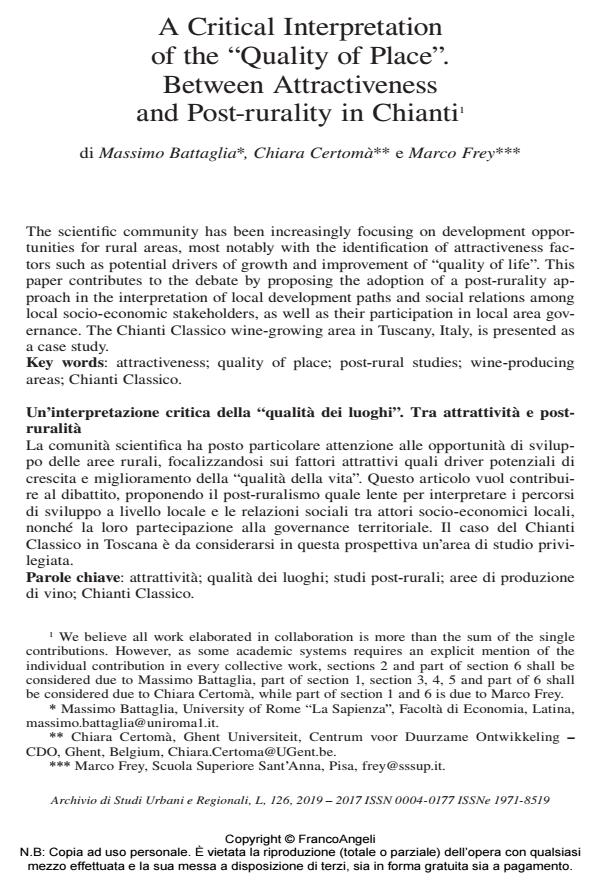A Critical Interpretation of the "Quality of Place". Between Attractiveness and Post-rurality in Chianti
Titolo Rivista ARCHIVIO DI STUDI URBANI E REGIONALI
Autori/Curatori Massimo Battaglia, Chiara Certomà, Marco Frey
Anno di pubblicazione 2019 Fascicolo 2019/126
Lingua Inglese Numero pagine 20 P. 77-96 Dimensione file 165 KB
DOI 10.3280/ASUR2019-126005
Il DOI è il codice a barre della proprietà intellettuale: per saperne di più
clicca qui
Qui sotto puoi vedere in anteprima la prima pagina di questo articolo.
Se questo articolo ti interessa, lo puoi acquistare (e scaricare in formato pdf) seguendo le facili indicazioni per acquistare il download credit. Acquista Download Credits per scaricare questo Articolo in formato PDF

FrancoAngeli è membro della Publishers International Linking Association, Inc (PILA)associazione indipendente e non profit per facilitare (attraverso i servizi tecnologici implementati da CrossRef.org) l’accesso degli studiosi ai contenuti digitali nelle pubblicazioni professionali e scientifiche
The scientific community has been increasingly focusing on development opportunities for rural areas, most notably with the identification of attractiveness factors such as potential drivers of growth and improvement of "quality of life". This paper contributes to the debate by proposing the adoption of a post-rurality approach in the interpretation of local development paths and social relations among local socio-economic stakeholders, as well as their participation in local area governance. The Chianti Classico wine-growing area in Tuscany, Italy, is presented as a case study.
La comunità scientifica ha posto particolare attenzione alle opportunità di sviluppo delle aree rurali, focalizzandosi sui fattori attrattivi quali driver potenziali di crescita e miglioramento della "qualità della vita". Questo articolo vuol contribuire al dibattito, proponendo il post-ruralismo quale lente per interpretare i percorsi di sviluppo a livello locale e le relazioni sociali tra attori socio-economici locali, nonché la loro partecipazione alla governance territoriale. Il caso del Chianti Classico in Toscana è da considerarsi in questa prospettiva un’area di studio privilegiata.
Parole chiave:Attrattività; qualità dei luoghi; studi post-rurali; aree di produzione di vino; Chianti Classico.
Massimo Battaglia, Chiara Certomà, Marco Frey, A Critical Interpretation of the "Quality of Place". Between Attractiveness and Post-rurality in Chianti in "ARCHIVIO DI STUDI URBANI E REGIONALI" 126/2019, pp 77-96, DOI: 10.3280/ASUR2019-126005